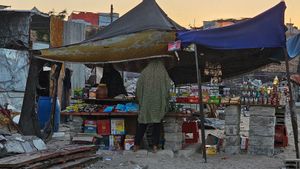JAKARTA - Britain has set a national lockdown. This was done in response to the spread of the new variant of the corona virus. What exactly does the mutation of the new coronavirus look like in the UK? Has it been detected in Indonesia?
Many were surprised by the development of COVID-19 cases at the end of 2020. They were even more surprised when analysis of the corona virus genome showed that there was a cluster of new mutations or variants in more than 50 percent of COVID-19 cases in the UK.
Not much detailed information that can be shared yet. There are at least five facts that we can describe about the new corona variant in the UK. These facts are listed in the Report of the WHO-China Joint Mission on Coronavirus Disease 2019.

This mutation of the corona virus was first detected in September. In November, British health authorities said a quarter of the COVID-19 cases in London were triggered by the transmission of a new variant of the coronavirus.
That figure increased in mid-December, with cases reaching nearly two-thirds. British Prime Minister (PM) Boris Johnson said the mutated corona virus has the ability to transmit between people of up to 70 percent. The figure appeared in a presentation by Dr Erik Volz from Imperial College London.
"It is really too early to say. But from what we have seen so far (the new variant of the coronavirus) is developing very fast. It (the latest mutation) is growing faster than (it has ever been. But it is important to keep an eye on this condition. "said Erik.
2. Questionable death ratesAlthough there are many narratives that call the new variant of the corona virus in the UK more dangerous, in fact there is no scientific evidence that can confirm the death rate of the new mutated corona virus. Experts are still monitoring and researching.
What is clear, as said in the first point, this mutation of the corona virus is more easily transmitted. People will be infected faster.
This has implications for the balance of the care system and the capacity of hospitals and medical personnel. The overwhelming medical system, of course, will be dangerous for the safety of every COVID-19 patient.
3. Early discovery and development of mutationsUntil the Report of the WHO-China Joint Mission on Coronavirus Disease 2019 was released, at least a new variant of the corona virus had been detected in three countries besides the UK: Australia, Denmark, and the Netherlands.
The initial appearance of this new variant of the corona virus is still being investigated. There are two possibilities so far. A new variant of the corona virus may appear in a patient in the UK or it can be imported from a country that has a lower ability to monitor the mutation process of the virus.
Specifically, new variants of the corona virus were found throughout the mainland of Great Britain, except Northern Ireland. However, the virus is highly concentrated in London, Southeast England and East England.
Regarding the development of mutations, the corona virus has mutated at least 17 types of the latest mutations. One of them is called the N501Y. This type is also known as the "receptor-binding domain". In addition there are also other types, such as A570D, P681H, T716I, S982A, D1118H, and D614G.

The new variant of the corona virus has various symptoms: fatigue, loss of appetite, headache, diarrhea, confusion, muscle aches, and a rash on the skin. The Report of the WHO-China Joint Mission on Coronavirus Disease 2019 (COVID-19) breaks down the common symptoms of the new COVID-19 variant into percentages:
- Fever (87.9 percent);
- Dry cough (67.7 percent);
- Fatigue (38 percent);
- Sputum production (33.4 percent);
- Shortness of breath (18.6 percent);
- Sore throat (13.9 percent);
- Headache (13.6 percent);
- Nasal congestion (4.8 percent).
Apart from those listed above, another symptom that the new COVID-19 variant shows is anosmia or loss of the sense of smell.
5. Is the current vaccine effective?Most researchers, especially those in the UK, believe that the average vaccine circulated in the world today can protect the body from the mutation of the corona virus. But the statement was delivered as an explanation of how the vaccines used in the UK responded to the new coronavirus variant.
However, the report also does not refer to any vaccine brands. However, if you look at the news, the UK is predominantly using the Oxford-AstraZeneca and Pfizer / BioNTech vaccines.
These vaccines are able to train the immune system and increase the body's ability to attack different parts of the virus. This means that even if a mutation causes a change in the virus, the vaccine should still work. At least until recently.
Experts do not rule out the virus will continue to mutate until it passes the capabilities of today's vaccines. A presentation by Glasgow University scientist Professor David Robertson stated: Viruses may be able to produce mutants that escaped vaccines.
6. Already entered Indonesia?The news about this is still confusing. When the Report of the WHO-China Joint Mission on Coronavirus Disease 2019 was released last December 2020, only three countries apart from the UK had confirmed the findings of a new variant of the corona virus mutation: Denmark, Australia, and the Netherlands.
In Indonesia, government authorities have not confirmed the existence of a corona virus mutation in Indonesia. The news of Kompas.com, Sunday, January 3, wrote a statement from the COVID-19 Handling Task Force saying they had not received a report on the findings of a new variant of the corona virus. However, mitigation efforts are made, including closing the door for foreign nationals (WNA).

However, on 29 December 2020, Gadjah Mada University (UGM) researchers announced the findings of four coronavirus mutations in Yogyakarta and Central Java. Through the FK-KMK Genetic Working Group, UGM and the team succeeded in identifying the Whole Genome Sequencing (WGS) of four isolates from Yogyakarta and Central Java that were suspected to contain the D614G mutation.
The D614G mutation in the SARS-CoV-2 virus has ten times higher infectious power and has spread in almost all corners of the world, namely 77.5 percent of the total 92,090 isolates containing the D614G mutation. Meanwhile, in Indonesia, 9 of the 24 isolates published have been reported to contain the D614G mutation.
"One third of them were detected in Yogyakarta and Central Java," said the Chairperson of the UGM FK-KMK Genetic Working Group, dr. Gunadi, Sp.BA., Ph.D. Quoted from the UGM website, Tuesday, December 29.
According to Gunadi, his party took thousands of isolate samples from Yogyakarta and Central Java, however, it was found that there were 15 samples that were known to have mutations, but after further testing only four isolates were considered mutated.
"Of the four samples, three samples from DIY and one sample from Central Java," he said.
Another research member from the FK-KMK Diagnostic Laboratory team, dr. Titik Nuryastuti said that the four samples of these mutated isolates were obtained after the team collected all samples from 98 health facilities (faskes) in DIY and 30 health facilities in Central Java. According to him, samples from this health facility were taken from various hospitals, health centers and the health office.
"The sample in DIY is more dominant, recorded 11,250 samples and 4,311 samples from Central Java. Overall, there were 1,083 who tested positive, "he said.
The English, Chinese, Japanese, Arabic, and French versions are automatically generated by the AI. So there may still be inaccuracies in translating, please always see Indonesian as our main language. (system supported by DigitalSiber.id)













